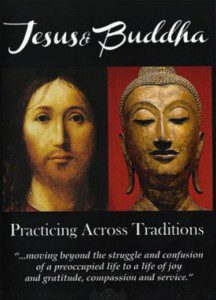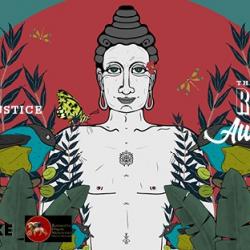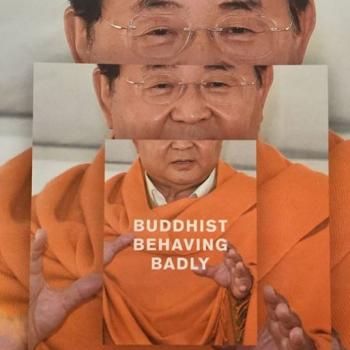 I sat down over the weekend to watch (for a second time), this short documentary, joined by two fellow PhD students, one a Theravadin Buddhist, the other a Roman Catholic. At just 44 minutes in length, it is brief, but perhaps it is the perfect length for a high school or university class on Comparative Religions or a faith group to watch over tea and cookies. The film features three people who are intimately familiar with both traditions:
I sat down over the weekend to watch (for a second time), this short documentary, joined by two fellow PhD students, one a Theravadin Buddhist, the other a Roman Catholic. At just 44 minutes in length, it is brief, but perhaps it is the perfect length for a high school or university class on Comparative Religions or a faith group to watch over tea and cookies. The film features three people who are intimately familiar with both traditions:
- Father Robert Kennedy, a Jesuit priest and Zen teacher;
- Chung Hyun Kyung, Professor of Ecumenical Theology and Interfaith Engagement at Union Theological Seminary and a Buddhist Dharma teacher; and
- Paul Knitter, Professor of Theology, World Religions and Culture at Union Theological Seminary.
And when I say ‘both traditions’ I must point out that a limitation of the documentary is that two people are/were Roman Catholic priests and all three are experienced in Zen/Soen Buddhism. As such, the Buddha you meet is the Buddha of Japan and Korea, while the Jesus you meet comes very much through the Roman Catholic tradition (while Chung Hyun Kyung is a Presbyterian, she does not express any ‘distinctively’ Presbyterian views that I/we noticed). That said, the documentary proves to be a welcome entrée into not only Buddhist-Christian dialogue, but also the discussion of the Ultimate or Absolute in general – a conversation that could go well beyond these two traditions.
http://www.youtube.com/watch?v=kRWm2YNPFA4
One of my first questions to my friends was “is this too New Age-y?” Both shook their heads. Despite needing to be brief and succinct, the discussions from all three of the people in the film were lucid, focused, and well grounded in tradition. Again, they are in the Zen tradition, so Theravadin and/or Tibetan conceptions of / problems with a Creator God are avoided. The Zen teachings conveyed simply suggested that the Ultimate (or absolute or salvation, etc) is not justoutside you, it is within, and it is within everyone. The trick is ‘waking up’ to this, moving beyond your old/separate/egoic/deluded self. Christian teachings were presented to suggest a parallel:
“For through the Law I died to the Law, that I might live unto God. I have been crucified with Christ, and it is no longer I who live, but Christ lives in me; and the life which I now live in the flesh I live by faith in the Son of God, who loved me and delivered Himself up for me.” (Galatians 2:19-20).
“Neither shall they say, Lo here! or, lo there! for, behold, the kingdom of God is within you.” (Luke 17:21)
“Know you not that you are the temple of God, and that the Spirit of God dwells in you?” (1 Corinthians 3:16)
Statements in these traditions require interpretation and discernment, but what these practitioners (and others) were able to do is use the teachings and practices of each tradition to more fully inform their own self-understanding and their own practice. Discussions about the problems that come up in trying to practice multiple traditions weren’t addressed, and, given the short time in the video, would have been difficult to give sufficient time to. It will be up to viewers to pick up on and discuss these and compare them with the convergences discussed in the video.
The DVD comes with a handy “Discussion Questions” insert and more can be downloaded at their website. I could see interested Muslims, Jews, Hindus and others also using it as a learning and discussion tool. For those still asking ‘why’ we should care about interfaith/comparative religious thought, the answer should be found in the world around you. You interact with people of different traditions all the time, and if you want greater understanding and perhaps for them to better understand you, these kinds of dialogues must take place. Not to be too political, but it should be obvious that a lack of cultural and religious understanding has been disastrous in our shared human history.
And not to be too anti-traditional, but every living tradition and every living culture is an open one and is already a product of this kind of dialogue(early Buddhism is a dialogue between the Buddha and Brahmins, Jains, and others; Chan is a product of Buddhism meeting Taoism and Confucianism; Zen is a product of Chan meeting Shintoism; and yes, Western/Modern Buddhism is a product of all of this meeting with Christianity, science, etc.). Christianity, too, has thrived on its ability to incorporate Platonism and the Stoics, and later Aristotle by way of Muslim philosophers.
As Max Müller said, “to know one religion is to know none.”
Annunciation
Even if I don’t see it again — nor ever feel it
I know it is — and that if once it hailed me
it ever does –And so it is myself I want to turn in that direction
not as towards a place, but it was a tilting
within myself,as one turns a mirror to flash the light to where
it isn’t — I was blinded like that — and swam
in what shone at meonly able to endure it by being no one and so
specifically myself I thought I’d die
from being loved like that.– Marie Howe
* For other perspectives, see this one by Dhivan Thomas Jones at the Western Buddhist Review, and Robert A. Jonas at Contemplative-life.org.











